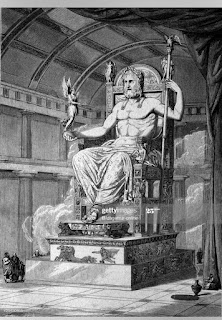The Greek sculptor Phidias, already renown for his earlier work, the Statue of Athena Parthenon, appropriately crafted his new 40-foot statue in the Temple of Zeus utilizing cedarwood, ivory, gold and ebony.
Seated on an opulent black marble throne, the god of sky, thunder and weather held a second statue in his hand, that of Nike, goddess of victory. In his other hand, he held a staff with a perched eagle. Allegedly, the statue had to be continually covered in olive oil as a safeguard from elemental erosion(!) The Temple of Zeus itself was located in Olympia, then controlled by the city-state of Elis, where every four years, fans congregated to witness its famed athletic games.
After eight years of construction, Phidias completed the statue in 5th Century BC which attracted awestruck onlookers from across the globe and dictated Zeus’s popular image in art, poetry and culture for centuries.
In 426 AD, the temple was destroyed in an earthquake but not before being desecrated and neglected by Roman emperor Theodosius I who banned all pagan cult activity, thus sidelining the Olympic Games for a spell.
But what became of Zeus? No longer a feature of the temple by the 6th Century, the statue of Zeus (formerly) of Olympia had seen renovation and subsequent relocation to Constantinople where anything from a tsunami, earthquake or fire may have claimed it.
That which we know of the majestic Statue of Zeus comes chiefly from its depiction in ancient art and coins. The timeline of its construction might also be a mystery were it not for the discovery of Phidias’ workshop in the 1950s. Little by little, discoveries of the such help us uncover the answers to the same age-old questions— When... where... how... and why?
Contact Chris: |  Christopher Robinson |



